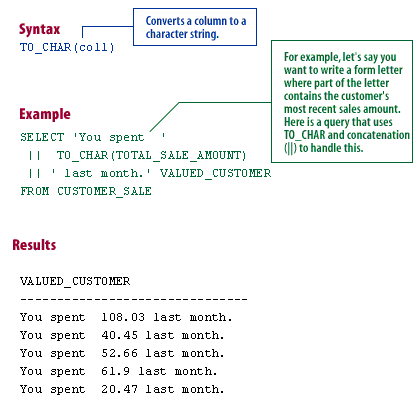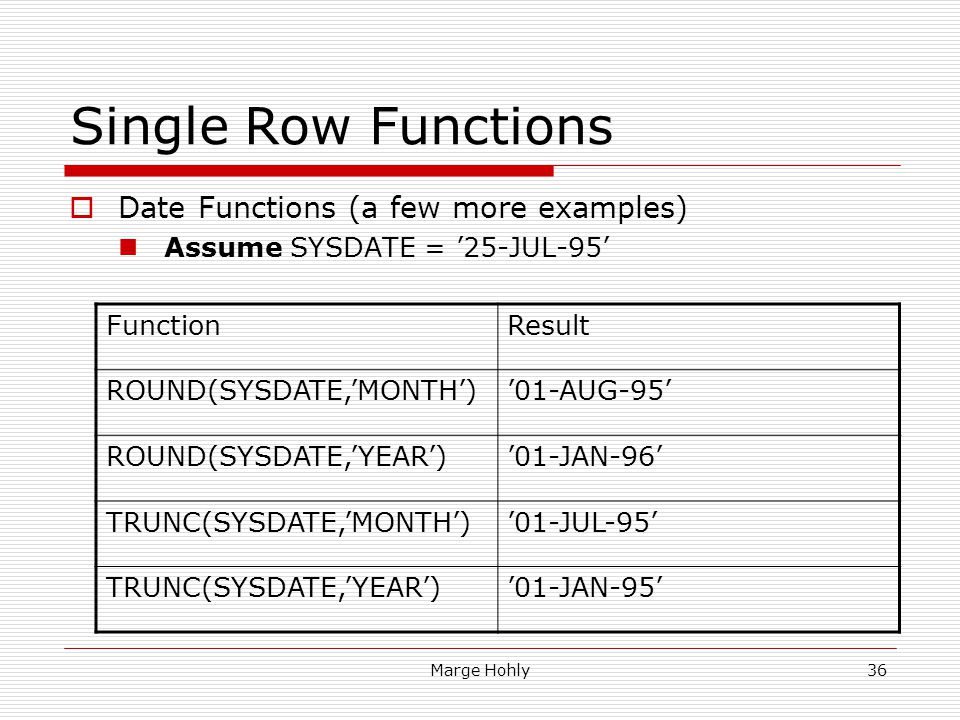
Winner of Best BI Software for SQL. Get the Most out of Your Data. Watch the Free Tableau Video Demo! Move Forward With Confidence. Connecting With The Data Community.

In this example , First, the TO_DATE() function converted a date string to a DATE value. Secon the TRUNC() function truncated the date. Because we did not pass the format argument, the TRUNC() function uses the default value that truncates the date to midnight. Thir the TO_CHAR() function formatted the result of the TRUNC() function. This tutorial explains how to use the TRUNC (date) function with syntax, parameters, examples and explanation.
Description of the illustration trunc _ date. The TRUNC (date) function returns date with the time portion of the day truncated to the unit specified by the format. The TRUNC ( date ) function returns date with the time portion of the day truncated to the unit specified by the format model fmt.
The value returned is always of datatype DATE , even if you specify a different datetime datatype for date. This example uses TRUNC after providing a date and time value, and truncates it to the hour. By default, x is truncated to the beginning of the day. The purpose of the Oracle TRUNC function is to truncate either a number or a date value. The TRUNC function works on two different data types – number or date.
This means you can provide it with either of these two data types, and the TRUNC function will perform slightly differently and give you a result. What is system date in SQL? Introduction to the PostgreSQL date_trunc function.
How to truncate table in Oracle procedure? The date _ trunc function truncates a TIMESTAMP or an INTERVAL value based on a specified date part e. In Oracle, TRUNC (datetime, unit) function allows you to truncate a datetime value to the specified unit (set zero time, set the first day of the month i.e). In SQL Server, you can use various expressions using CONVERT function to get the same result.
Check if current date is between two dates Oracle SQL. Without a doubt, strings and numbers are important, but it is certainly a very rare application that does not also rely on dates. You need to keep track of when events. In Oracle, TRUNC function, when applied for a datetime value, truncates it to the specified part (to day, by default). In MySQL, you can use DATE or DATE _FORMAT functions.
If you omit fmt, then date is truncated to the nearest day. Refer to ROUND and TRUNC Date Functions for the permitted format models to use in fmt. Use TRUNC ( Date value) in where clause: 6. TRUNC on this check and need to use BETWEEN operator. I have an Oracle PLSQL code generating a list of datetime stamps and I would like to truncate them to the specific hours of 7am and 7pm rather than the beginning of the day. The SYSDATE function returns the current date and time value whose type is DATE.
The format of the returned date time value depends on the value of the NLS_ DATE _FORMAT parameter. But, as you will see in this little Quick Tip, it is not always that smart. PostgreSQL TRUNC() function with Example : The PostgreSQL trunc() function is used to truncate a number to a particular decimal places. If no decimal places is provided it truncate toward zero(0).
TRUNC(SYSDATE ) removes the time element from the date. Any date that has been fed through the TRUNC function has a date of midnight. Creating a time-series with truncated timestamps. DATE _ TRUNC () is particularly useful when you want to aggregate information over an interval of time. Are these two date formats equivalent?
Is one format preferred over the other? If you have worked with SQL for a while – you have most likely had a time where you wanted to show in a query the difference between two dates. It can be for example to calculate how long a person has been hired in your company, how old a person is today, etc.
Nincsenek megjegyzések:
Megjegyzés küldése
Megjegyzés: Megjegyzéseket csak a blog tagjai írhatnak a blogba.